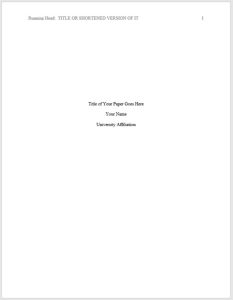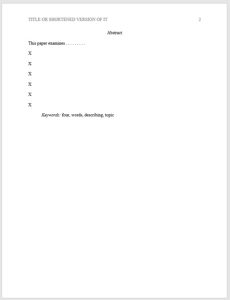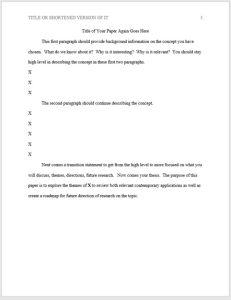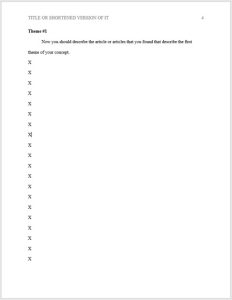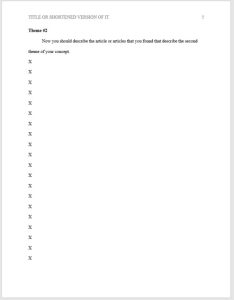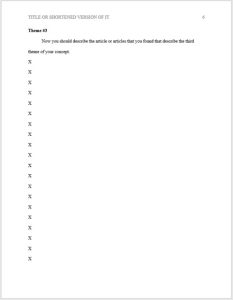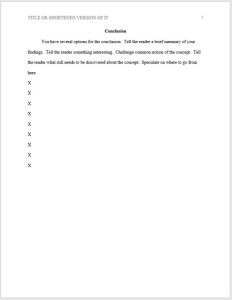3 How to conduct the literature review
Choose and narrow your topic.
The first step in writing a literature review is to determine the purpose of your literature review. Are you writing an undergraduate paper, a thesis, a dissertation, or a manuscript for publication. Understanding this will give you both parameters and a general goal to work towards – how long, how in depth do I need to review, how far back in history should I begin my review, etc. The assignment or task given to you will determine the scope of your project and the time you need to spend on it. This scope will also give you a narrow focus on a topic and hence make the project more manageable. For example, research emotional intelligence as a literature review topic is far too broad, even for the most rigorous assignment such as a manuscript for publication. Rather, the context of emotional intelligence as it relates to organizational outcomes (that is, what benefits come to managers who utilize emotional intelligence well?), this becomes a more realistic project. If you need ideas on which topic to write about, you can ask your peers which ideas they have discarded or currently considering. Ask your professor which topics are most relevant to your level of study. If you are looking for a dissertation topic, ask a practitioner which problems or challenges they are dealing with. If you are an academic researcher, look for articles that make claims such as “this topic lacks a unifying theme” or a field where scholars are disagreeing with each other regularly on a single topic. These sorts of debates in the literature are fertile areas for literature reviews to summarize latest findings.
Search the literature
Once you have narrowed the topic to a singular focus, you need to employ a database or search engine to find articles relevant to your topic. Remember, we are only looking for the peer-reviewed articles for your literature review. You should not be gleaning blogs, Wikipedia, business press, news websites, etc. for information. Rather, you should consider starting with google scholar, Web of Science, Scopus, EBSCO, ERIC, or your local university or public library database. Many libraries still contain volumes and volumes of academic journals in hard copy format before most of the journals went completely online. When you search these
databases you will need to choose a handful of keywords or main ideas to search. This should give you an adequate starting point for articles. You should then consider synonyms or related concepts to serve as keywords as well. Once you start learning about the subject, you might see various names for the same concept or idea. For example, Corporate Social Responsibility is also referred to as stakeholder theory, sustainability, triple bottom line, sustainable development creating shared value, corporate citizenship, and simply – social responsibility. Understanding the various names and synonyms comes with more searches and familiarity with the topic. The more advanced you get in your research role, the more familiar you will become with the literature.
A second source of good articles for a literature review is in previous literature reviews. Literature reviews are snapshots in time, and scholars regularly summarize the field or current state of the research field. Some fields advance faster than others and require more frequent literature reviews. These outdated literature reviews are great starting places to identify previous themes, seminal authors, and contributors to the research. Keep in mind these are only starting places. If the last literature review was conducted 10 years prior, there are 10 years of development that also need to be reviewed and included in your project. However, use the previous literature reviews to find good articles. Then you can search specifically for those articles either directly at the publisher’s website, library database, or google scholar.
Selection and evaluation of articles
In your search, let’s suppose you found 40 articles that are clearly related to your research topic, and another 10 articles that you think are related but not quite sure. At this point you will now dive into the articles themselves. Start by saving all of the articles in pdf format and putting them in one place on your computer. Some scholars and students will print out the articles at this point as an alternative. The good news is that at this step, you do not need to read every single article. Rather, you should go through each article’s abstract and make a note of the key takeaway or thesis of the article. Most articles have abstracts which are free to access and many of them will come with keywords associated with them to help you search them. Literature reviews can be conducted as either chronological, or thematic. As you begin to take notes, you can decide which of these two approaches make the most sense. If the field developed slowly over a long period of time, it might make sense to approach it chronologically. If the field developed quickly, or advances were made more recently, you might consider organizing your literature review into themes, instead of following it as a historical progression. At this point you should be looking for patterns, important trends, and influential theories. If you printed off the articles, you can put them in piles with post-it notes that describe the themes of each. If you downloaded the pdf, you can create subfolders with the themes and place the articles in each of these folders. Whether you chose chronological or thematic, you should then map out the ideas and categories of the articles you found.
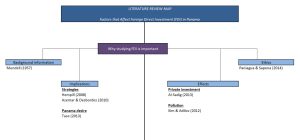
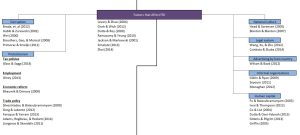
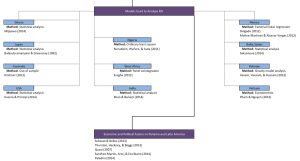
Begin writing
You can begin by creating a draft of the literature review using the literature review map that you have created. If you are writing a stand-alone literature review, you can begin by writing the introduction. Provide background information and argue for the relevance or timeliness of your literature review. Then provide some transition for the thesis statement and provide a clear picture of what your literature review will entail and what the reader can expect. If you are writing the literature review as part of a section of a paper, then you can do a condensed version of the introduction, and include it in the section of the literature review. You still need to argue for the relevance of the literature review, but you also need to describe how your research project will add to the research field you are describing in your literature review. Write the content of the literature review based on your chronological or thematic choice. For articles that are more relevant, you should describe in detail. For more ancillary contributions such as contextual applications of your concept, you can summarize in briefer descriptions, or a more summarized approach. The purpose of the assignment (remember step 1) will determine how in depth you need to go into the literature for your review. For the content, you don’t need to cover every single article. Instead, rely on the patterns and themes to describe what researchers have found. If you find 10 articles with the exact findings, you don’t need to cite all of them, but you can make statements in your content that the articles you are citing are not the only ones which made this finding. The conclusion should be a focus on either direction for future research (for a stand alone paper), or how your research project advances the field of knowledge (for a literature review as a section of a paper).
Templates to follow
The stand alone research paper as an academic paper might use the following outline:
- 1) Introduction – describe the topic, its relevance, and timeliness. Why is a literature review needed at this point in the literature. Describe for the reader a high level summary of what has been found to-date without going into too much detail. Remember the purpose of the literature review is to describe the giants shoulders, and why this is a jumping off point for the next decade of research. Use the introduction as an argument for how your paper does both of these. Your paper should have a thesis statement that guides the reader through the rest of the paper.
- 2) Themes – The core of a literature review is the findings of the research articles that you found. The thematic approach would result in several sections, and sub sections of the themes.
- 3) Conclusion – The conclusion is the author’s chance to give future scholars a light to follow. Not only does the writer need to provide future direction of research, but that future direction needs to be justified. Does learning more about a subject allow us to better apply it, will it save lives, or money, or time, or create a deeper understanding for altruistic purposes? Will researching the topic advance new fields or compliment related ones? Will researching the topic re-affirm a shaky understanding of the field, and thereby creating more solid ground upon which to stand for future research?
